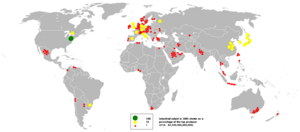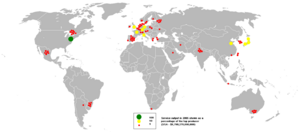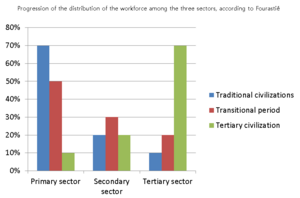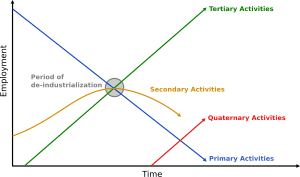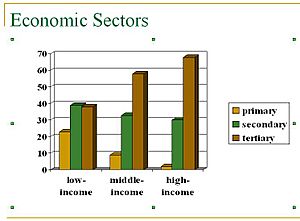Three-sector model facts for kids
The three-sector model helps us understand how a country's economy works. It divides all the jobs and businesses into three main groups, called sectors. These are:
- Primary sector: This is about getting raw materials from nature. Think farming, fishing, mining, and forestry.
- Secondary sector: This is where raw materials are turned into finished products. This includes factories that make cars, clothes, or computers.
- Tertiary sector: This sector provides services instead of making physical goods. It includes things like teaching, healthcare, banking, and transportation.
This model was created by economists like Allan Fisher, Colin Clark, and Jean Fourastié in the early 1900s. It shows how countries usually change as they grow.
When a country is just starting to develop, most of its money comes from the primary sector. As it grows, more money comes from factories (secondary sector). Finally, in very developed countries, most money comes from services (tertiary sector).
Some economists have added even more sectors, like the quaternary and quinary sectors. This is because our world now has many jobs focused on information and special services.
Contents
How Economies Change Over Time
Jean Fourastié described how countries move through different stages. He believed this change was a good thing. It could lead to a better quality of life and more education. He saw the number of people working in each sector change like this:
First Phase: Traditional Societies
In this early stage, most people work directly with nature. They use very few machines. This phase is like Europe in the Middle Ages. Many developing countries today are in this stage.
- Primary sector: About 64.5% of workers
- Secondary sector: About 20% of workers
- Tertiary sector: About 15.5% of workers
Second Phase: The Change Period
During this phase, countries start using more machines, especially in farming. This means fewer people are needed to grow food. So, workers move from farms to factories.
Factories start making more goods, and new jobs appear. This stage often begins with the Industrial Revolution. This is when machines and assembly lines become common. The service sector also starts to grow.
- Primary sector: About 40% of workers
- Secondary sector: About 40% of workers
- Tertiary sector: About 20% of workers
Third Phase: Service-Based Societies
In this advanced stage, machines and robots do much of the work in farming and factories. So, fewer people work in those areas. Instead, more and more people work in the service sector. This includes jobs like doctors, teachers, and shopkeepers.
- Primary sector: About 10% of workers
- Secondary sector: About 20% of workers
- Tertiary sector: About 70% of workers
What Fourastié Got Wrong
While Fourastié's ideas were helpful, some of his predictions didn't quite come true.
For example, he thought that the service sector would never have job losses due to technology. But then computers came along! The digital revolution changed many service jobs.
He also thought that countries in the third phase would have very few factory jobs. But countries like Germany still have a strong factory sector because they export many goods.
Finally, he thought that service jobs would always need high education. But many service jobs, like cleaning or delivery, do not. He also predicted more equal incomes, but in many countries, income differences have grown.
Adding More Sectors
As economies grew, the service sector became huge. So, some economists divided it even further. They added new sectors for jobs based on information and special human services.
Quaternary Sector
The quaternary sector is all about information and knowledge. It includes jobs that help with future growth and development.
This sector includes:
- Scientific research
- Computer technology (ICT)
- Education
- Consulting (giving expert advice)
- Managing information
- Financial planning
These jobs provide services directly. They don't rely much on physical goods. The amount of information produced in this sector has grown very fast.
Quinary Sector
The quinary sector is a bit different depending on who you ask. Some say it includes non-profit work, like jobs for charities.
Others say it focuses on very high-level human services and decision-making. This includes top government officials, important scientists, and senior business leaders. These are often called 'gold collar' jobs. They involve making big decisions or creating new ideas and technologies.
See also
 In Spanish: Hipótesis de los tres sectores para niños
In Spanish: Hipótesis de los tres sectores para niños


